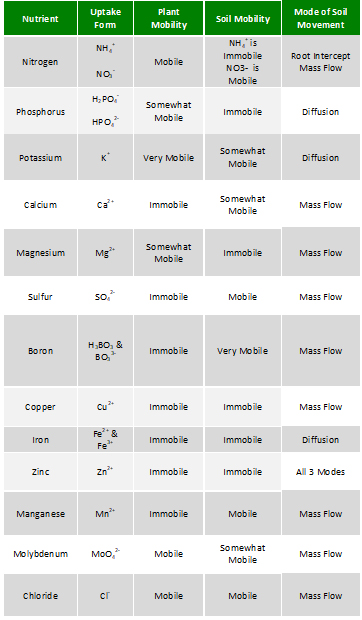- Both too much and to little soil moisture can affect soil nutrient availability
- Soil nutrients reach plant roots in one or a combination of three ways: mass flow, diffusion or root intercept
- Soil nutrients need to be in soil solution for uptake
- Plant transpiration plays a key role in plant nutrient uptake
- Dry soil conditions can cause nutrient deficiencies
- Wet conditions can decrease plant nutrient through leaching, denitrification and volatile sulfur loss to the atmosphere
- Lack of air filled pore space means lack nitrogen for rhizobia to fix for legumes
So far it has been a growing season of soil moisture extremes.Soil moisture differences, whether to dry or to wet can have a big effect on nutrient availability.Soil nutrient loss, air deprived soil environments and atypical plant respiration all tax the normal soil processes that occur below ground.
For soil nutrient to be plant available they need to be in soil solution.Soil nutrients reach roots in one or more ways through: mass flow, diffusion, or root intercept.Nutrients such as NO3-nitrogen, SO4-sulfur, calcium, boron, molybdenum, and manganese primarily travel to the roots via mass flow along with water.Nutrients that move from areas of lower concentration to higher concentration (diffusion) via soil moisture include phosphorus, potassium, and to a lesser extent iron.What creates these vectors of movement to the roots is plant transpiration (loss of plant moisture thru stomatal openings). As the plant draws soil moisture in thru the roots nutrients come in contact with root surface and are exchanged.As the turgor pressure (internal water pressure) of the plant increases, the guard cells allow opening of the stomata, expelling water vapor into the surrounding air creating this directional flow from soil into the plant.Intern, nutrient uptake by the plant lowers soil concentrations of nutrients close to the root and in reaction to this area of lower concentration nutrients diffuse from areas of higher concentration.The ideal soil moisture content for crop growth (corn, soybeans, wheat, and alfalfa) exists when approximately at 50% of the entire pore space is occupied by water.When soil moisture levels stray to the dry side, lower soil solution creates lower plant available nutrients.When soil moisture levels rise to the high side, directional flow of soil moisture downward carries nutrients with it creating a vector of flow greater than evapotranspiration (soil surface evaporation & plant transpiration combined) creates upward.
Early this season dry conditions and small root masses of young corn, created some nutrient deficiencies.Lack of soil solution decreased mass flow of potassium, zinc and manganese to young roots systems.Once rains came, reports nutrient deficiencies from FS member companies decreased.Nutrient deficiencies were early enough in the growing season that yield impact should be negligible.
Recent heavy rains in many areas have left many fields saturated.Even though soil nutrients are in solution, lack of soil air can leave legumes like soybeans in need of nitrogen and rendered formed plant nodules inactive for a period of time.In addition, as soil moisture moves downward out of the soil profile into the range of the water table nitrate, sulfate, molybdate, borate and chloride leach downward thru the soil profile out the crops root zone.Nitrate in this oxygen deprived soil environment is subject to anaerobic bacteria activity that converts nitrate to nitrite to nitrous oxide and eventually nitrogen gas that is lost to the atmosphere.This conversion process we call denitrification.
